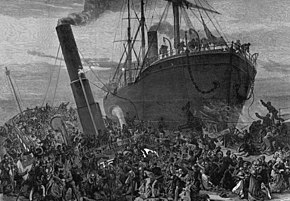 Artist's impression of the collision | |
| Date | 3 September 1878 |
|---|---|
| Time | Between 7:20 pm and 7:40 pm |
| Location | Gallions Reach, River Thames, England |
| Cause | Collision |
| Casualties | |
| 600 to 700 dead | |
SS Princess Alice, formerly PS Bute, was a British passenger paddle steamer that sank on 3 September 1878 after a collision with the collier SS Bywell Castle on the River Thames. Between 600 and 700 people died, all from Princess Alice, the greatest loss of life of any British inland waterway shipping accident. No passenger list or headcount was made, so the exact figure of deaths has never been known.
Built in Greenock, Scotland, in 1865, Princess Alice was employed for two years in Scotland before being purchased by the Waterman's Steam Packet Co to carry passengers on the Thames. By 1878 she was owned by the London Steamboat Co and was captained by William R. H. Grinstead; the ship carried passengers on a stopping service from Swan Pier, near London Bridge, downstream to Sheerness, Kent, and back. On her homeward journey, at an hour after sunset on 3 September 1878, she passed Tripcock Point and entered Gallions Reach. She took the wrong sailing line and was hit by Bywell Castle; the point of the collision was the area of the Thames where 75 million imperial gallons (340,000 m3) of London's raw sewage had just been released. Princess Alice broke into three parts and sank quickly; her passengers drowned in the heavily polluted waters.
Grinstead died in the incident, so the subsequent investigations never established which course he thought he was supposed to take. The jury in the coroner's inquest considered both vessels at fault, but more blame was put on Bywell Castle; the inquiry run by the Board of Trade found that Princess Alice had not followed the correct path and her captain was culpable. In the aftermath of the sinking, changes were made to the release and treatment of sewage, and how it was transported to, and released into, the sea. The Marine Police Force—the branch of the Metropolitan Police that had responsibility for policing the Thames—were provided with steam launches, after the rowing boats used up to that point had proved insufficient for the rescue. Five years after the collision Bywell Castle sank in the Bay of Biscay with the loss of all forty crew.